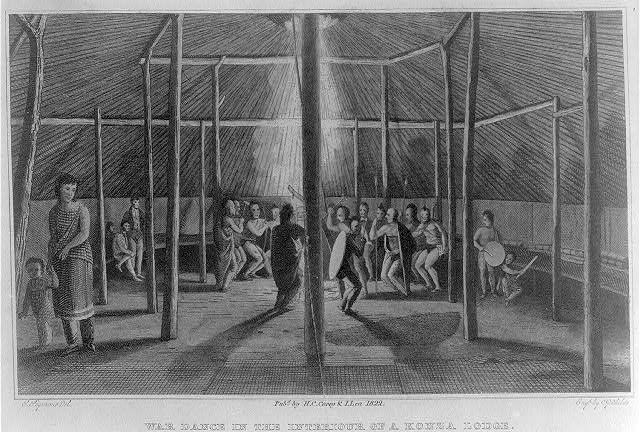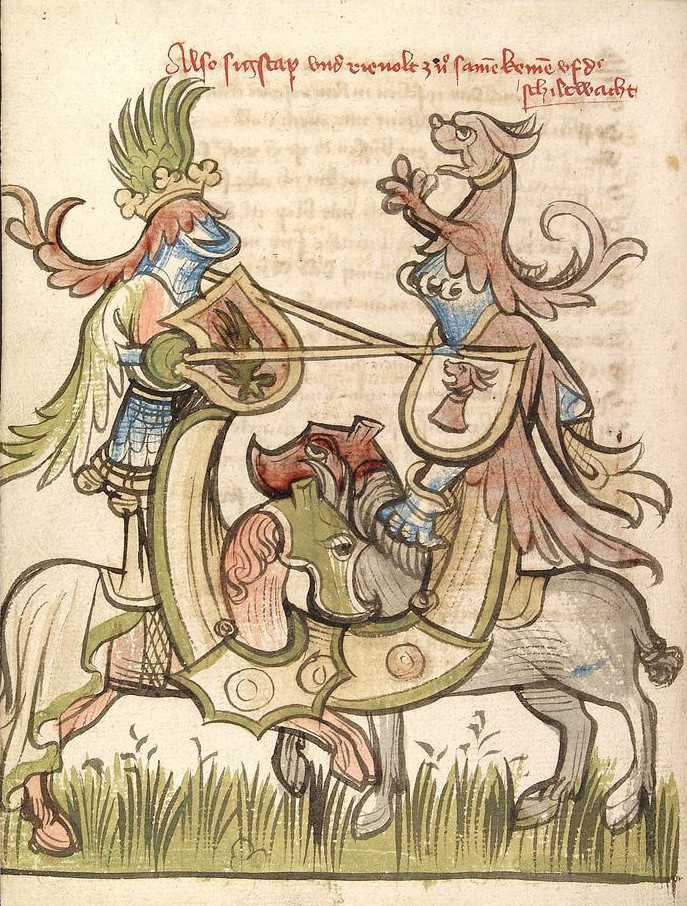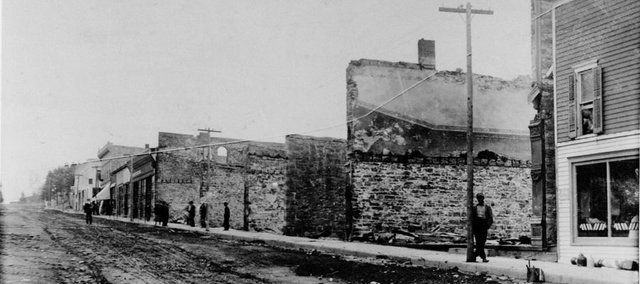|
Kansas City Renaissance Festival
The Kansas City Renaissance Festival is a Renaissance fair held each fall in Bonner Springs, Kansas, United States, next to Sandstone Amphitheater. Each year the fair begins on Labor Day weekend and continues for seven weekends, open on Saturdays and Sundays as well as Labor Day and Columbus Day. The faire began in 1977 as a benefit for the Kansas City Art Institute, and became a stand-alone event in the late 1990s. Presently, the fair has 165 booths and 13 stages, entertaining 200,000 patrons annually on 16 operating days. In keeping with its artistic beginnings, KCRF features over 150 shops and vendors, many of which sell original crafts and artwork. The site itself is artistic, featuring winding tree-lined lanes, painted murals, and banner-strewn, fancifully decorated buildings. In particular, the Institute for Historic and Educational Arts (IHEA) maintains a large presence. Its artisans demonstrate a variety of textile, wood and metal crafting techniques, even operating a fully ... [...More Info...] [...Related Items...] OR: [Wikipedia] [Google] [Baidu] |
Kansas City Renaissance Festival Logo
Kansas ( ) is a landlocked U.S. state, state in the Midwestern United States, Midwestern region of the United States. It borders Nebraska to the north; Missouri to the east; Oklahoma to the south; and Colorado to the west. Kansas is named after the Kansas River, in turn named after the Kaw people, Kansa people. Its List of capitals in the United States, capital is Topeka, Kansas, Topeka, and its List of cities in Kansas, most populous city is Wichita, Kansas, Wichita; however, the largest urban area is the bi-state Kansas City metropolitan area split between Kansas and Missouri. For thousands of years, what is now Kansas was home to numerous and diverse Plains Indians, Indigenous tribes. The first settlement of non-indigenous people in Kansas occurred in 1827 at Fort Leavenworth. The pace of settlement accelerated in the 1850s, in the midst of political wars over the Slavery in the United States, slavery debate. When it was officially opened to settlement by the U.S. governm ... [...More Info...] [...Related Items...] OR: [Wikipedia] [Google] [Baidu] |
COVID-19 Pandemic
The COVID-19 pandemic (also known as the coronavirus pandemic and COVID pandemic), caused by severe acute respiratory syndrome coronavirus 2 (SARS-CoV-2), began with an disease outbreak, outbreak of COVID-19 in Wuhan, China, in December 2019. Soon after, it spread to other areas of Asia, and COVID-19 pandemic by country and territory, then worldwide in early 2020. The World Health Organization (WHO) declared the outbreak a public health emergency of international concern (PHEIC) on 30 January 2020, and assessed the outbreak as having become a pandemic on 11 March. COVID-19 symptoms range from asymptomatic to deadly, but most commonly include fever, sore throat, nocturnal cough, and fatigue. Transmission of COVID-19, Transmission of the virus is often airborne transmission, through airborne particles. Mutations have variants of SARS-CoV-2, produced many strains (variants) with varying degrees of infectivity and virulence. COVID-19 vaccines were developed rapidly and deplo ... [...More Info...] [...Related Items...] OR: [Wikipedia] [Google] [Baidu] |
Festivals In Kansas
A festival is an event celebrated by a community and centering on some characteristic aspect or aspects of that community and its religion or cultures. It is often marked as a local or national holiday, mela, or eid. A festival constitutes typical cases of glocalization, as well as the high culture-low culture interrelationship. Next to religion and folklore, a significant origin is agricultural. Food is such a vital resource that many festivals are associated with harvest time. Religious commemoration and thanksgiving for good harvests are blended in events that take place in autumn, such as Halloween in the northern hemisphere and Easter in the southern. Festivals often serve to fulfill specific communal purposes, especially in regard to commemoration or thanking to the gods, goddesses or saints: they are called patronal festivals. They may also provide entertainment, which was particularly important to local communities before the advent of mass-produced entertainment. F ... [...More Info...] [...Related Items...] OR: [Wikipedia] [Google] [Baidu] |
List Of Open Air And Living History Museums In The United States
This is a list of open-air and living history museums in the United States. Ecological and environmental living museums Farm museums Alabama *Landmark Park, Dothan Alaska *Alaska Native Heritage Center, Anchorage California *Ardenwood Historic Farm, Fremont, California, Bay Area *California Citrus State Historic Park, Riverside *Orcutt Ranch Horticulture Center, Los Angeles * Rileys Farm, Oak Glen, 17th and 18th c. Living History, Revolutionary War, Civil War & Gold Rush * Stein Family Farm / National City Living History Farm Preserve, San Diego Colorado *Littleton Museum – The Farms, Littleton *Old Town Museum, Burlington Florida *Mission San Luis de Apalachee, Tallahassee *Morningside Nature Center, Gainesville *Panhandle Pioneer Settlement Living History Museum, Blountstown Georgia *Agrirama, Tifton * Historic Westville, Columbus Hawaii *Kona Coffee Living History Farm, Kona District Illinois * Blackberry Farm, Aurora *Corron Farm, Campton Hills *Garfield ... [...More Info...] [...Related Items...] OR: [Wikipedia] [Google] [Baidu] |
Society For Creative Anachronism
The Society for Creative Anachronism (SCA) is an international living history group with the aim of studying and recreating mainly Medieval European cultures and their histories before the 17th century. A quip often used within the SCA describes it as a group devoted to the Middle Ages "as they ought to have been", choosing to "selectively recreate the culture, choosing elements of the culture that interest and attract us". Founded in 1966, the non-profit educational corporation has over 20,000 paid members as of 2020 with about 60,000 total participants in the society, including members and non-member participants. History The SCA's roots can be traced to a backyard party of a UC Berkeley medieval studies graduate, the author Diana Paxson, in Berkeley, California, on May Day in 1966. The party began with a "Grand Tournament" in which the participants wore helmets, fencing masks, and usually some semblance of a costume, and sparred with each other using weapons such as plywood ... [...More Info...] [...Related Items...] OR: [Wikipedia] [Google] [Baidu] |
Jousting
Jousting is a medieval and renaissance martial game or hastilude between two combatants either on horse or on foot. The joust became an iconic characteristic of the knight in Romantic medievalism. The term is derived from Old French , ultimately from Latin">-4; we might wonder whether there's a point at which it's appropriate to talk of the beginnings of French, that is, when it wa ... , ultimately from Latin "to approach, to meet". The word was loaned into Middle English around 1300, when jousting was a very popular sport among the Anglo-Normans, Anglo-Norman knighthood. The synonym tilt (as in tilting at windmills) dates . Jousting on horse is based on the military use of the lance by heavy cavalry. It transformed into a specialized sport during the Late Middle Ages, and remained popular with the nobility in England and Wales, Germany and other parts of Europe throughout the whole of the 16th century (while in France, it was discontinued after the death of King Henry II ... [...More Info...] [...Related Items...] OR: [Wikipedia] [Google] [Baidu] |
Historical Reenactment
Historical reenactment (or re-enactment) is an educational entertainment, educational or entertainment activity in which mainly amateur hobbyists and history enthusiasts dress in historical uniforms and follow a plan to recreate aspects of a historical event or period. This may be as narrow as a specific moment from a battle, such as a reenactment of Pickett's Charge presented during the 1913 Gettysburg reunion, or as broad as an entire period, such as Regency reenactment. While historical reenactors are generally amateurs, some participants are military Military personnel, personnel or historians. The participants, called ''reenactors'', often research the equipment, uniform, and other gear they will carry or use. Reenactors buy the apparel or items they need from specialty stores or make items themselves. Historical reenactments cover a wide span of history, from as far back as ancient warfare, the medieval warfare era, and the early modern warfare, to as recent as the World War I ... [...More Info...] [...Related Items...] OR: [Wikipedia] [Google] [Baidu] |
List Of Renaissance Fairs
This is a list of Renaissance faires and other Medieval-themed faires worldwide. North America United States Included below are the notable Renaissance, Medieval, and Fantasy fairs held in the United States. These include: any long running (20 plus years) fairs, and established fairs (5 plus years) that have a two-weekend or more annual run. Generally, U.S. renaissance fairs are open weekends only (including holidays) during the periods indicated. (Dates are codified to facilitate searching by date.) ::Table Key:† Permanent = majority of venue comprises permanent, outdoor, purpose-built structures in a stable site; Semi-permanent = outdoor event occurs regularly at stable public or private venue (e.g.: public parks; private farms, etc.) and features some permanent purpose-built structures; Recurring Event = event occurs regularly at stable public or private venue (e.g.: public parks; private farms, etc.) but with no purpose-built structures; any event with temporary struct ... [...More Info...] [...Related Items...] OR: [Wikipedia] [Google] [Baidu] |
KCTV
KCTV (channel 5) is a television station in Kansas City, Missouri, United States, affiliated with CBS. It is owned by Gray Media alongside MyNetworkTV affiliate KSMO-TV (channel 62). The two stations share studios on Shawnee Mission Parkway in Fairway, Kansas; KCTV's transmitter facility, the KCTV Broadcast Tower, is located in the Union Hill, Kansas City, Union Hill section of Kansas City, Missouri. Channel 5 was the fourth television channel to go on the air in Kansas City; KCMO-TV began broadcasting on September 27, 1953, as the television adjunct of KCMO (AM), KCMO radio. Originally an American Broadcasting Company, ABC affiliate, it switched to CBS in 1955 as part of a group affiliation agreement negotiated by the Meredith Corporation, which agreed to buy KCMO radio and television less than a week after KCMO-TV began broadcasting. In 1956, the present tower, a Kansas City landmark, was completed to broadcast the station. Despite protests from Kansas City civic leaders, KC ... [...More Info...] [...Related Items...] OR: [Wikipedia] [Google] [Baidu] |
Wyandotte County, Kansas
Wyandotte County () is a county in the U.S. state of Kansas. Its county seat and most populous city is Kansas City, with which it shares a unified government. As of the 2020 census, the population was 169,245, making it Kansas's fourth-most populous county. The county was named after the Wyandot tribe. History Wyandot tribe The county is named after the Wyandot (also Wyandott or Wyandotte) Indians. They were called the Huron by the French in Canada, but called themselves Wendat. They were distantly related to the Iroquois, with whom they sometimes fought. They had hoped to keep white Americans out of their territory and to make the Ohio River the border between the United States and Canada. One branch of the Wyandot moved to the area that is now the state of Ohio. They generally took the course of assimilation into Anglo-American society. Many of them embraced Christianity under the influence of missionaries. They were transported to the current Wyandotte County ... [...More Info...] [...Related Items...] OR: [Wikipedia] [Google] [Baidu] |
Bonner Springs, Kansas
Bonner Springs is a city in Wyandotte, Leavenworth, and Johnson counties, Kansas, United States. It is part of the Kansas City, Missouri Metro Area. As of the 2020 census, the population of the city was 7,837. Bonner Springs was incorporated as a city on November 10, 1898. Bonner Springs is home to the Azura Amphitheater (previously named the Sandstone Amphitheater), the National Agricultural Center and Hall of Fame, Wyandotte County Historical Museum, and the annual Kansas City Renaissance Festival. History Coronado Spanish explorer Francisco Vázquez de Coronado spent the winter of 1541-1542 at what is now the area of Bonner Springs. The diary of Father Juan Padilla records that the expedition reached the 40th degree (Kansas northern border) and came to a great river (the Missouri). An inscription found on a stone near Atchison has been translated as, "Thus far came Francisco de Coronado, General of an Expedition." The explorers traveled downstream to the mouth of ... [...More Info...] [...Related Items...] OR: [Wikipedia] [Google] [Baidu] |
Minnesota Renaissance Festival
The Minnesota Renaissance Festival is a Renaissance fair, an interactive outdoor event which focuses on recreating the look and feel of a fictional 16th Century "England-like" fantasy kingdom. It operates during seven consecutive weekends, from mid-August until the final week in September (or sometimes the first weekend in October) on a site near the Minnesota River in Shakopee, a suburb of the Twin Cities. The Minnesota Renaissance Festival began on September 11, 1971, with Tovah Feldshuh as the Queen, in Jonathan, Minnesota. More than 25,000 people visited the two-weekend grand opening of the festival, at which time it was called Minnesota Renaissance Fair (changed to Minnesota Renaissance Festival later on) and promoted as “A Celebration of Nature, Art and Life!” It was at the Jonathan site in 1971 and 1972. In 1973, it moved to a farm on highway 41 up the hill orthfrom Chaska, according to info on page 17 of the book "The History of the American Renaissance Festival" by ... [...More Info...] [...Related Items...] OR: [Wikipedia] [Google] [Baidu] |








